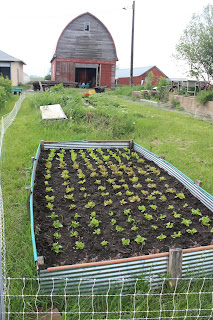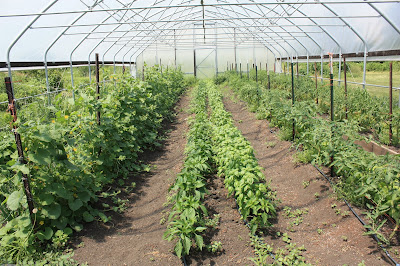Our
Foresight 2020 Campaign continues with a post exploring some of the major changes we will endeavor in the next season of growing at the Genuine Faux Farm. One of the first things on our minds is looking for ways to deal with the excessive moisture that has made it increasingly difficult for us to succeed. So, in this blog post we ask:
Is it enough to raise the bed?
 |
| Note the growing areas that are not under water. |
The problem is this. We've had numerous seasons of late where we have had above average precipitation. In fact, we set some all-time records for
rain and
snowfall in 2018/2019. Our ground is flat, the soil is heavy and the water table is typically on the higher side. The number of times we have experienced "100 year storms," "500 year storms" and "1000 year storms" has far exceeded the 1%, 0.2% and 0.1% chances they are supposed to have for likelihood of occurrence. I think we outline the issues we have to deal with when things get really wet on our farm in this year's post titled:
Clueless No More.
 |
| Basil and tomatoes looking fairly good in August. |
Our Spring planting was delayed by four to five weeks this season because our soils were simply too wet to work. Even with that delay, we still had some decent looking crops as we went into August. Not all of the crops looked good, mind you, but there were hints that we might still know a thing or two about horticulture. There were also numerous hints that our land still has some capacity to cap.
 |
| September - how we rue you! |
But, we got into September again this year and our entire Fall has been fairly damp. It's a notch or two below 2018, but considering Iowa averages show ever decreasing rainfall amounts as you go into the Fall months, the slight reduction isn't much of a consolation.
So, what are we going to do? We're
cutting back the number of crops we are growing in 2020. We are hopeful that by reducing the number of crops and the amount of space we cultivate, we can spend some time adapting our farm to wetter (and probably warmer on average) conditions. In short, we're going to become earth movers.
 |
| This worked in prior wet years. |
We have had a couple of raised beds on the farm for a few years now and they are a place we can plant most of the time. It is a bit of pain that we have to irrigate these more often, but the alternative (unwatering the plants when it rains too much) really isn't possible. The soil surface for these beds are about twelve inches above the surrounding area, so the plants and their entire root zone are unlikely to be saturated even during some of the most difficult rainy conditions.
The problem is that this space is very limited and we can't raise bigger areas this much. In fact, we wouldn't want to do too much of this because we know there will still be dry periods and we don't want to pull up that much ground water to irrigate.
 |
| Raised growing areas in Eden. |
We actually dug out the paths in one of our high tunnels and added soil to the growing areas this past year. Why? Well, we've had so much moisture that water was actually seeping into the tunnel via the high water table. The plants needed a few more inches of soil so they could stay healthy. Happily, this worked for us in 2019 and Eden was again a happy growing place.
The issue is that this approach does not completely solve the problem in the field.
 |
| Look again at our first picture. |
If you take a second look at the first picture in the blog, you can see that we DID have raised areas for our plants. The wheel tracks for our tractor remained lower. The problem is that the root zone remained saturated to a point that the plants suffered and many died.
Our proposed solution is to mirror the approach we had for Valahalla, our second high tunnel.
 |
| Valhalla |
Prior to putting up this structure, we had two ditches dug along the long sides and we used that dirt to raise the pad for the building. In the end, it is only a two to three inch difference. But, it seems to be enough. Even the field that was NOT covered by the high tunnel in 2019 did reasonably well. So, our plan is to have 18' to 20' wide growing areas flanked by 6' to 8' swales. This is going to require significant time and effort on our part and the earth moving will have to occur at times when it is dry enough to move the soil successfully. Hence, some of the reason we are paring down our growing plans and adjusting how we deliver our produce to everyone.
The good news?
If this is successful, we hope that we can see more consistent success with our crops once again. But, we also see this as an opportunity to provide more natural habitat within our farm AND a chance to deal with the water without passing it all
downstream to become someone else's problem. We feel good about all of this in principle. We are asking for your support and best wishes as we work to get better. We'll keep you informed on the process in our blog and elsewhere as we find out...
Is it enough to raise the bed?







No comments:
Post a Comment
Thank you for your input! We appreciate hearing what you have to say.
Note: Only a member of this blog may post a comment.